In this Article:
Both the .308 Win and the .30-06 Springfield are two cartridges steeped in American tradition. Both have serviced the men and women of our military and police force and have found worldwide success and longevity in the hunting fields.
In this article, we will take a look at these two cartridges and compare and discuss the similarities and differences between factory loads of these two widely accessible rifle cartridges. We will take a look at performance and terminal ballistic characteristics of both as well as their price, availability, and uses.
Unlike most other caliber or cartridge comparisons you will come across, our goal at Sniper Country is not to crown one cartridge as better than the other. To do so would be nonsense in our eyes and going about it in such a manner would quickly skew the narrative. We do not benefit in any way from whatever cartridge you use. We just want to provide a better source of information compared to what is out there now. When looking at the .308 Win vs .30-06 Springfield, it will become obvious that each has particular areas where they excel. Rather than pick one over the other, we simply want to point out why having both is beneficial and in what situations you might choose one over the other.
A Brief History
.308 Winchester
The .308 Winchester was introduced to the shooting world by Winchester in 1952 where it quickly became a staple in the American hunting world. Not long afterward, its performance specs were impressive enough to be adopted by the military, and it saw heavy use in Vietnam before being replaced by lighter loads.
While the NATO version of this round was short lived, it has and will continue to have a loyal and dedicated market for the avid hunter. This is a larger bullet with excellent range, penetration, and stopping power. It’s a great medium to large game caliber and can be used for just about any large game animal in the world under the right conditions.
While the .308 has found its place in the hunting world, it’s performance has also proven reliable enough to find a spot in police and military sharpshooting units and with competitive long range shooters. While it might not be as prevalent in these circles as it once was, the fact that it is still used is a testament to its effectiveness and we don’t see any concern for its longevity.
Because of the popularity of this caliber, which comes from its performance, there is a wide variety of ammunition with various bullet weights and designs making it easy to match your ammunition with your intended hunting or shooting scenarios. Most bullet weights fall between the 150 and 180-grain weight, but there are lighter and heavier loads available.
.30-06 Springfield
The .30-06 was developed in 1906 and throughout the years saw modifications, especially to bullet design and also saw combat in several wars until it was replaced in the late 70’s by none other than the NATO version of the .308 Win.
Though retired from military service, the .30-06 is a well-known hunting cartridge that is sought after for its velocity, power, and flat trajectory to take down larger game cleanly beyond 500 yards. While we have no data to back this up, we would bet that even people who have never hunted or spent time on the range has heard of the .30-06. We think it is just that immersed in US culture.
The .30-06 is widely available in just about any retail store that sells ammunition. It has a huge selection of bullet weights as well as designs that allow to .30-06 to be used in a variety of hunting situations. The .30-06 can also be an extremely hot load when hand loaded, increasing its performance greatly.
Specs
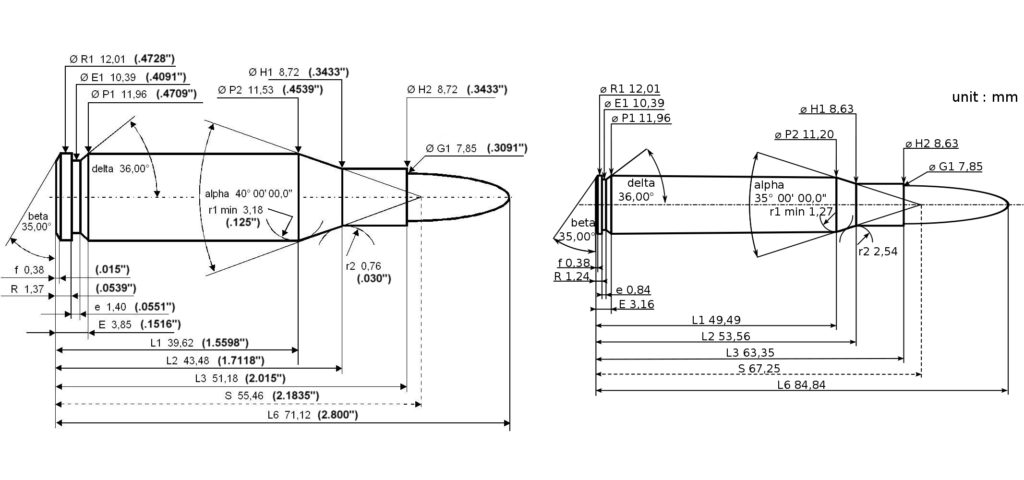
| .308 Win | .30-06 Sprg | |
|---|---|---|
| Parent Casing | .300 Savage | .30-03 |
| Bullet Diameter | 0.308" | 0.308" |
| Neck Diameter | 0.3433" | 0.340" |
| Case Length | 2.015" | 2.494" |
| Overall Length | 2.8" | 3.34" |
| Case Capacity | 56gr | 68gr |
| Max Pressure (SAAMI) | 62,000psi | 60,200psi |
Both of these cartridges take a bullet of the .308 caliber, and both have similar neck diameters as would be expected. The .30-06 Springfield casing and bullet are longer and slimmer than the .308 and can hold a larger amount of powder charge. Though the case, the .308 design is better suited to withstand higher pressures and makes it able to be loaded with slightly hotter burning powder. Both of these are hard hitting rounds, and we will take a look at how these differences affect performance. The overall length of the cartridges does influence the types of rifles that can be used. Generally, rifles chambered for the .308 cartridge are short action while the .30-06 calls for long action rifles. It might not be relevant to some, but it is worth mentioning.
There is such a wide range of rounds for both of these cartridges that it’s near impossible to draw back the scope broad enough to compare them all and have room to discuss the results without publishing a book. Because of this, we are going to take a look at five of the more popular factory loads for each cartridge that encompasses hunting and shooting competition rounds and several bullet weights and designs. By doing this, we can draw some conclusions on which cartridge, and rounds within the cartridge, are better suited for certain applications. Below we have listed the ten rounds we will be examining for the rest of the article.
 .308 Winchester Super-X 180gr
.308 Winchester Super-X 180gr .308 Nosler Ballistic Tip 165gr
.308 Nosler Ballistic Tip 165gr .308 Federal Vital-Shok Ballistic Tip 150gr
.308 Federal Vital-Shok Ballistic Tip 150gr .308 Hornady BTHP Match 168gr
.308 Hornady BTHP Match 168gr .308 Federal Gold Medal Sierra Matchking 175gr
.308 Federal Gold Medal Sierra Matchking 175gr
 .30-06 Federal Vital-Shok Nosler Partition 165gr
.30-06 Federal Vital-Shok Nosler Partition 165gr .30-06 Hornady GMX Superformance 150gr
.30-06 Hornady GMX Superformance 150gr .30-06 Federal American Eagle Jacketed Hollow Point 150gr
.30-06 Federal American Eagle Jacketed Hollow Point 150gr .30-06 Nosler Custom Hand Loaded AccuBond 200gr
.30-06 Nosler Custom Hand Loaded AccuBond 200gr .30-06 Federal Gold Medal Sierra Matchking 168gr
.30-06 Federal Gold Medal Sierra Matchking 168gr
This is by no means a comprehensive list of available rounds for each cartridge. There are a lot of selections for factory loads out there, and when you factor in hand loading, the number increases exponentially. Every marksman out there has their favorite ammunition and tend to defend it beyond reason. Just because you don’t see it here doesn’t mean we do not endorse it, but we have to limit our selections.
While we will only be graphing these ten rounds, we didn’t stop working there. We compiled many more rounds and we will present the averages of those data sets to you at the end of each section. This will help us keep the visuals a little more clean while still providing you with more data. Having a larger sample size also makes everyone a little more confident that the trends we might see between these two cartridges is an accurate indicator of the cartridges as a whole.
We should also point out what data we are using and where it is coming from. Everything that we will look at is computer generated data that we compiled from the manufacturer or generated with ballistic calculators. And we know that there is not a single one of us who would rather generate all of this data through field work but the bottom line is that most of us do not have the time nor the funds for such an endeavor. Even so, computer generated data is not that bad and it even has some benefits over hard data when it comes to comparing two cartridges. We can control for a lot of variables that could change from day to day or even shot to shot. And while some of these numbers are not going to be dead on what you would see if you fired them from your rifle, the trends we see between the cartridges should not be affected.
So, let’s get down to comparing these two storied and still relevant cartridges.
Recoil
Whether you are hunting or are out on the range, recoil has the potential to throw off a shot. For those new to shooting rifles, recoil can also be a pretty intimidating concept and is even more capable of throwing off an inexperienced shooters shot. Because of this, we are going to take a look at the recoil between these two popular cartridges.
Before we start looking at the individual rounds of each cartridge, let’s take a general look at how the recoil energy of both stack up next to each other (Graph 1).
Both of these numbers were generated using a 7lb rifle, and we will keep this constant when looking at our rounds. We see that both generate over 20ft.lb of force, which is a generous amount of recoil and can cause flinching for inexperienced shooters. In this case, the .30-06 generates a few more lbs of recoil than the .308, but we will see how that holds up when we look at our selected rounds.
For our rounds, we used kept the 7lb gun weight the same for all. For powder loads, we used the common grain weight for each caliber. Now obviously, the amount of recoil generated is going to be influenced by more or less powder charge added to the cartridge, so you need to keep that in mind when looking at this data. For the sake of comparison, we kept the powder charge constant for each round of the same cartridge with the number coming from averages of common load weights we took from several respected loading guides. And because we are examining factory loads, we went with more conservative amounts of powder rather than with max loads as is the case with most rounds from the manufacturer. Though the force can fluctuate, we are still going to be able to see the general trends of the force generated between these two cartridges.
So, let’s take a look at our ten rounds and see how the force generated compares between rounds (Graph 2).
As the first graph, we still see a general trend of the .30-06 rounds producing a few lbs of energy than the .308. More importantly, you will notice that the recoil energy generated depends on a lot of the specific components of each round. The very light 125gr .30-06 round from Remington produces less than 20ft.lb of force compared to the nearly 30ft.lbs of force generated by the much heavier 200gr bullet from Nosler.
Overall, when looking at rounds of similar weight, we see more recoil energy produced by the .30-06 cartridge with a higher powder charge. With handloads, you might be able to squeeze in some more powder with the .308 or less with the .30-06, and you would have even closer results when comparing recoil of the two cartridges. Of course, doing this will change the ballistic properties of the rounds which we will get into shortly.
One more note is that we are looking at the force generated and not specifically the “felt recoilâ€. Felt recoil is going to depend a lot of your shooting technique as well as firearm characteristics. Still, force generated still translates to felt recoil to some extent, especially when keeping the variables consistent as we have done here.
Let’s take a look at the average recoil energy generated by these two cartridges when we use the larger sample set. The recoil energy was calculated using the same variables that we just described.
Average Recoil (ft.lb)
| .308 Winchester | .30-06 Springfield |
|---|---|
| 22.15 | 23.2 |
With the larger data set, we still see the trend of the .30-06 rounds bringing a bit more recoil energy than the .308 Win rounds. We do see the two averages tighten up a bit more than what we saw with the smaller sample size. With just barely over a ft.lb difference between the two cartridges, there is not a whole lot of discussion. Both of these cartridges have rounds that vary quite a bit around the average. So if you’re wanting lighter recoil, it isn’t really a question of which cartridge you should pick but the individual round.
Ballistics
Any marksmen, whether they spend most of their time shooting at the range or in the woods but most likely both apply, will be concerned with how their bullets behave once they leave the barrel. In this section, we will take a look at the velocity, ballistic coefficients, and trajectories of our ten rounds. With this information, we can begin teasing apart under which situations one might choose one of these cartridges over the other.
Velocity
The velocity of a bullet is key for both hunting and range shooting purposes and it influences so many other ballistic and terminal performance categories of a round. The hotter the load, the more penetration you are apt to get, which is important for hunting purposes. Higher velocity, paired with the correct twist rate in your barrel, makes the bullets less susceptible to environmental influences which in theory, should make the round easier to put on target.
With this in mind, velocity is an important ballistic property for hunters and competitive shooters alike. We have compiled load data for each of the ten rounds we have selected for this comparison (Graph 3).
We are looking at the velocity from the muzzle out to 500 yards and is measured in ft/s or commonly seen presented as fps.
All of these rounds display supersonic velocities even out to 500yards with most of them likely to maintain supersonic velocities around the 1,000 yard mark and is something we will take a closer look at. The rounds from both cartridges also seem to bleed off velocity around the same rate as they move downrange.
Looking at these selected rounds, there is not a large difference in velocity when comparing the .308 vs .30-06. We can see some differences from round to round if you are looking for a little more giddy-up, but it’s nothing significant. Of course, if your handloading you can probably sneak a few more grains into the .30-06 cartridge to widen the gap against a .308.
Let’s make sure that the lack of difference between these rounds is correct by looking at the velocity averages for our larger data set.
Average Velocity (ft/s)
| Yards | .308 Win | .30-06 |
|---|---|---|
| Muzzle | 2733 | 2822 |
| 100 | 2521.5 | 2601 |
| 200 | 2320 | 2391 |
| 300 | 2182 | 2191.9 |
| 400 | 1946.5 | 2001 |
| 500 | 1775 | 1828 |
We still do not see much difference between the average velocity numbers of these two cartridges. With that, the .30-06 rounds do maintain a higher average throughout the flightpath though the difference never exceeds 100fps. If you look at the velocities of individual rounds (not shown) you will also find that a lot of rounds for both cartridges overlap. The highest performing rounds, at least from this set of data, are all .30-06 factory loads.
Another interesting metric we can use to compare two cartridges, or really any two rounds, is how long the bullets will remain in supersonic flight. You probably aren’t going to see a lot of factory loads of these cartridges in competitions and you aren’t going to need this information when it comes to hunting. Still, it’s fun to look at and there might very well be some of you out there wanting to test the limits of factory loads for these cartridges.
Average Supersonic Limit (Yards)
| .308 Winchester | .30-06 Springfield |
|---|---|
| 1023.7 | 1050 |
So, the supersonic limits of rounds are important to long range marksman because during supersonic flight, the bullets are most stable. This is not the case 100% of the time, but mostly. When bullets fall below supersonic speeds, a lot more environmental factors have greater influence on the bullet and the stability of the bullet falters a little. Because of this, shots taken at a distance greater than its supersonic limit are going to require more skill and understanding to be accurate.
When looking at these two cartridges, we see that their averages are again very similar. Both have averages a little over the 1,000 yard mark with the .30-06 rounds having a little over 25 extra yards of supersonic flight. It’s still not accurate to say that the .30-06 has a clear advantage over the .308 Win in this category. While the top performing round from this data set is a .30-06 round, there are a lot of .308 rounds that outcompete a lot of .30-06 rounds. We will see this in a lot of categories comparing these two cartridges. It’s really more of a comparison between individual rounds than the cartridges as a whole.
Ballistic Coefficient
Some shooters pay a lot of attention to ballistic coefficient while others probably are unaware of what it is or what it means. It can get pretty complicated when you dive into the physics of it, but we don’t see the need to dive to deep.
In the simplest of terms, the ballistic coefficient is derived from an equation using several bullets and cartridge variables. This number gives you an idea of how streamlined a bullet is. The higher the ballistic coefficient, the better the bullet can resist wind drag and wind drift. A bullet more resistant to these factors is going to be less likely to be pulled off its flightpath and theoretically will be a more accurate round.
Let’s take a look at our ten selected rounds and see how they stack up against each other when looking at the ballistic coefficients (Graph 4).
We gathered these numbers from the factory loads manufacturers.
Like we will see with most of the performance specs when comparing the .308 vs .30-06, there is not so much a discernable difference between the two cartridges, but more so from round to round. All but one round have BCs above .4 which are excellent ratings. Only the heavy 180gr .308 round has a BC below that threshold. The averages for these BCs give a slight advantage to the .30-06, but it’s always tough to give credence to averages with only a few rounds. You never know what might be an outlier.
We aren’t willing to decide based on these numbers alone. Both the hunting rounds as well as the match grade ammunition have the BCs to back up a decision to use them for normal shooting situations. They are not the highest ballistic coefficients you will find with modern bullet design, but they are more than adequate for what factory loads are most often used.
Let’s take a look at the averages of our larger data set and see what the two cartridges look like.
Average Ballistic Coefficient
| .308 Winchester | .30-06 Springfield |
|---|---|
| 0.434 | 0.427 |
When we add some more rounds to the mix, we actually see the .308 Win rounds have a slightly higher BC than the .30-06 cartridge average, which confirms why we didn’t want to put all our eggs in the results of the smaller sample size. Even though the .308 BC average is slightly higher, there is nowhere near enough difference to say that the cartridge as a whole brings better ballistic coefficients. If you look at the individual factory loads for each cartridge, there are good BCs and there are lower BCs floating around.
Trajectory
The trajectory is what just about every hunter or competitive shooter of every skill level will be interested in when comparing two different cartridges. A few hours online and you will find forums trashing one cartridge over the other and people talking about how flat shooting their round of choice is and its superiority to the other. You will find cases and arguments for both the .308 and .30-06. We have even been sucked into the never ending argument of the more flat shooting cartridge.
What’s even more frustrating with most of these arguments is that there are hardly ever numbers attached to the claims. We hope that with our selection of rounds and the data procured from the manufacturers, we can provide a more unbiased look at the trajectory of the .308 vs .30-06 debate.
Before we take a look at the individual rounds we have selected, we wanted to show a pulled out view of the trajectory of these two cartridges that isn’t muddled. We selected two rounds, one from each cartridge, that are made from the same manufacturer, have the same bullet design, and are of similar bullet weights (Graph 5).
Looking at a .308 and .30-06 Federal Sierra MatchKing BTHP we see that the trajectory is very similar between both cartridges with only a few inches difference between the two at the 500-yard mark. While there are flatter shooting rounds of the same cartridge, it shows you that when you have a lot of similarities between the two cartridges, they have just about the same amount of bullet drop throughout their trajectory.
Short Range Trajectory
Let’s take a look at all of the selected rounds we are using for this comparison and take a look at the short range trajectory, which is comprised of ranges most often used in the hunting world (Graph 6).
We are looking at firearms zeroed in at 100 yards and measured out to 300 yards. We are measuring the bullet drop, in inches, for each selected round.
Again, we see a lot of similarities at how these bullets behave along their flightpath. At the 200 yard mark, there is less than 2″ of difference between all of the .308 and .30-06 rounds. When we move out to the 300-yard mark, there is still minimal difference between the two types of cartridges with the most being 5″ of difference in bullet drop between the flattest and steepest dropping bullets. Interestingly, the flattest and the steepest are bullets from the same cartridge. What we see is that it depends on the bullet weight more so than the cartridge. All of the rounds that showed the most bullet drop at the 300-yard range all have bullet weights of 175gr+. So again, we are seeing that, despite all the arguments, these two cartridges are showing a lot of the same ballistic properties.
When we see numbers between two cartridges that are so similar and have a lot of overlap in their individual factory loads, it’s even more important to take a look a larger data set to see if the trends hold. You will find the average bullet drop in the table below. We have also added a 400 yard mark to see if extending the range leads to the same similarities or if this range we start to see a cartridge begin to separate itself from the other.
Average Bullet Drop (Inches) at Short Range
| Yards | .308 Win | .30-06 |
|---|---|---|
| 50 | -0.125 | -0.155 |
| 100 | 0 | 0 |
| 200 | -4 | -3.71 |
| 300 | -14.5 | -13.67 |
| 400 | -32.8 | -31 |
With more rounds added into our analysis, we still see the same trends that we saw in the graph. We still see less than an inch of difference between the two cartridges at the 200 yard mark and at 300 yards. When we extend out to the 400 yard mark, we do see a little more difference in the bullet drop with a little under two inches of difference. At the 200, 300, and 400 yard mark, the .30-06 has the flatter trajectory, but it is by a slim margin.
We see a larger trend at this point, that there is not a lot of difference between these two cartridges. If we were to graph all of these rounds and not label them, you could easily mistake all of them for the same cartridge. And like all of the other categories thus far, there are higher and lower performing rounds for both the .30-06 and the .308.
Long Range Trajectory
Both of these rounds carry the distinction of being good long range cartridges. Let’s take a look at the long range trajectories of our selected rounds and see if there begins to be some distinction in bullet drop at further ranges (Graph 7).
Firearms were zeroed at 200 yards and data comes from measured bullet drop (in inches) out to the 500-yard mark.
Out to 300 yards, we don’t see any difference when looking at the .308 vs 30.06. Out to 400 yards, we do start to see some differences in bullet drop between the ten rounds. The bulk of the rounds are still clustered tightly together with only about 5″ max of difference. We do see the heavier 180gr .308 round begin to fall off more dramatically and we also see the lighter and higher velocity 150gr .30-06 Hornady round showing a flatter trajectory. This same trend continues out to the 500-yard mark. Again, most of the rounds cluster pretty tightly together and fall within a 10″ range of each other. The two outliers distance themselves even further from the main groupings.
What we can take away is that again, based on the .308 vs .30-06 argument, there is not a whole lot of difference between the two cartridges. At least, this is the case from this set of selections. There are rounds for each cartridge that gives you a flatter trajectory at increased distances. I know it might be getting a little boring getting the same results but that is just what the numbers are showing us. We still have quite a few categories to go yet and things might get a little more interesting.
Where you might begin to see some bigger differences in the two rounds is when you get into handloading. Manufacturers do not load their cartridges up with the maximum amount of powder. When handloading, the .30-06 cases have more room than the .308 and when loaded properly, you can make some pretty hot .30-06 loads that might give you a better long range trajectory than .308 rounds. Of course, the effectiveness of those loads are going to depend heavily on the person doing the loading.
There is also the possibility that 500 yards is not far enough to begin to see where these two cartridges begin to separate. So, when we look at the averages for these rounds, we will also extend the range out to a 700 and 1,000 yard checkpoints.
Average Bullet Drop (Inches) at Long Range
| Yards | .308 Win | .30-06 |
|---|---|---|
| 100 | 2 | 1.8 |
| 200 | 0 | 0 |
| 300 | -8.5 | -8 |
| 400 | -24.7 | -23.6 |
| 500 | -50.3 | -48.3 |
| 700 | -137.6 | -133.4 |
| 1000 | -401.6 | -397.7 |
When we look at the long range trajectory, we still see a lot of the same between these two cartridges out to the 400 yard mark. At this point, there is 1.1 inches of difference between the two averages with the advantage going to the .30-06 rounds. From this point on, we do start to see the gap between the two cartridges widen. At 500 yards, we see the gap widen to a whopping two inches.
Now, that’s still not too big a margin but there are arguments that two inches difference in trajectory at this range is quite a difference. The reason why we joke is because if you look at individual rounds at this distance, there is still plenty of overlap between these two cartridges.
At 700 and 1000 yards, the gap widens a little bit more but the two cartridges still show a lot of similarity with less than five inches of difference. The top two performing rounds at each yard marker are .30-06 rounds, but there are still a lot of .308 Win rounds up there in the top tier of rounds in terms of trajectory.
Stopping Power
While competition shooters might not be as interested in stopping power as hunters, it’s an important factor that we can’t afford to leave out. For hunters, stopping power is important for several reasons. The first is safety, especially if you are hunting larger predators, coming up on a wounded animal can be a dangerous situation. Secondly, most hunters want enough stopping power to be able to make a clean and humane kill of the animal with causing unneeded suffering. Finally, a clean kill means you are not going to have to track a wounded animal sometimes a couple hundred yards and possibly in the dark.
We will take a look at the kinetic energy that is associated with bullets traveling downrange and also look at the penetration potential for all of our selected rounds. To look at the penetration potential for these cartridges, we will take a look at two methods of comparison. The first will be through the sectional density and the second will be through bullet momentum.
Though these will be the only components of stopping power that we will look at in this comparison, you should already know that there are many more components that influence stopping power. The problem is that the other factors are harder to near impossible to quantify using computer generated data. So, their omission from this article is not from us minimizing their importance. In fact, one both bullet design and shot placement are two of the most, if not the most, important components to stopping power.
And since you are here reading this article, there is a good chance that you have come across plenty of forums where the topic and subsequent nasty arguments come up for which metric is the best indicator for how well a round will perform in regards to stopping power. Two of the components you will most often find is kinetic energy and momentum. Both of which are metrics we will look at.
Just so you know where we stand, we think that only looking at one metric is a mistake. They are different numbers and give us different aspects of a rounds performance. For getting any idea of a round’s stopping power, understanding the KE, the momentum, the sectional density, and bullet design are all critical in getting a full picture of how the round will perform. And like we mentioned earlier, all of these numbers don’t mean squat unless you’re putting the round where it needs to go.
Energy
When a bullet is fired from the barrel, it carries kinetic energy that upon impact is transferred to the target. This large amount of force is very destructive to the marks surrounding tissue and organs. As you can imagine, the bigger the game, the more energy you are going to need to cause enough damage for a clean kill. The energy is only part of the equation to stopping power, but it is an important one.
Just to have some sort of marker to understand how much energy these rounds carry and how it relates to hunting, a common guideline for kinetic energy and a rounds usefulness for certain game is that medium sized game, such as whitetail and antelope, is that you need at least 1,000ft.lb of energy. For larger game such as elk, you need to go up in energy closer to 1,500 ft.lb. For even larger game, throw another 500ft.lb on top of that. And again, these are just guidelines.
If we look at our rounds and their associated energy (ft.lbs) as they move downrange, do we see any differences between the .308 Win and .30-06 Springfield (Graph 8)?
From the muzzle out to 100yards, all of the rounds are carrying well over 2,000ft.lbs of force and is more than enough to take down large game. Regarding differences between the two cartridges, there are a few .30-06 rounds that have more energy than the .308 rounds, but that also might just be selection bias. There are one or two .308 rounds that are up there, but we could easily find some .308 rounds that match the .30-06.
All of the selected rounds carry over 1,500ft/lbs of energy at the 300-yard mark. Very few hunters are going to be consistently taking shots over this range, and both the .308 and .30-06 cartridges carry more than enough energy to cleanly take down an animal. Now, not all of these rounds are the best for hunting due to the bullet design, but you get the idea.
Once we get out to the 500-yard mark, all rounds are still working with 1,000+ ft.lbs of force which is still enough to drop medium game and even larger game with proper shot placement. Like at earlier ranges, there are several .30-06 rounds that 1,300+ ft.lbs of force while only one .308 round. Even so, there is not enough distinction to pick one of these cartridges over the other based on kinetic energy that the bullets carry downrange.
If we look at the averages from these rounds, we see that the .30-06 cartridge has a slight advantage over the .308 Win but it is still not a major difference that really blows open the case. Still, that may just be a result of too few samples.
Let’s take a look at the kinetic energy averages when we have a larger data set and see if we get some more distance between these two cartridges.
Average Bullet Kinetic Energy (ft.lbs)
| Yards | .308 Win | .30-06 |
|---|---|---|
| 0 | 2723 | 2922.9 |
| 100 | 2319.9 | 2484 |
| 200 | 1966.5 | 2102 |
| 300 | 1657.9 | 1770.8 |
| 400 | 1389.7 | 1485.4 |
| 500 | 1159.5 | 1241.8 |
At the muzzle, the .30-06 Springfield has right at 200 more ft.lbs of energy than the .308 Win rounds. Which was a little higher than what we saw from the small set of rounds that we graphed. As the rounds move out further, the difference between the two cartridges diminishes to around 75 to 100ft.lbs of energy. And while there is still some overlap between the individual rounds though the .30-06 cartridge has more rounds in the top tier of performance in this case. Regardless, both cartridges have excellent kinetic energy and more than meet most guidelines for hunting medium to large game in North America, especially within 300 yards.
Penetration (Sectional Density)
A lot of factors go into a bullets ability to penetrate a target. The velocity is one factor as is the bullets design. Bullets that do not expand will penetrate deeply, but not cause as much tissue damage. Fast expanding bullets will cause larger wounds, but might not penetrate down to vital organs of larger game.
Another factor is the sectional density of the bullet. The sectional density is calculated by using the bullet weight and bullet diameter. As we already know, both of the cartridges use a .308 caliber bullet, so the bullets weight is going to be what determines the differences in SD. How sectional density equates to penetration is the diameter where force is applied. Heavier bullets with the same diameter are going to penetrate deeper than lighter rounds with the same diameter. If we have two bullets with the same weight, but different diameters, the smaller diameter localizes the force to a smaller area and gives you deeper penetration.
Ballistic gels are a great method for measuring penetration, but unfortunately, we do not have the equipment to test all of the rounds we have been looking at. Still, by looking at the sectional density (SD) of the rounds, we can get an idea of how well these different bullets can penetrate and gives us a basis for comparison (Graph 9).
If we look at the sectional densities of our ten rounds, we see that there is no difference at all when trying to make inferences between the .308 vs .30-06 and their penetration potential. Both cartridges can take bullets of the same weights and they utilize the same caliber bullet so we don’t expect to see much difference. So the only factor that is going to make a huge difference is the design of the bullet, which can be used for either cartridge. Again, we find ourselves looking at two cartridges that have very similar properties and characteristics. And we haven’t forgotten about bullet momentum, but again, the similarities that we have seen in the velocities between these rounds also hint that we will not see a lot of difference between the two cartridges as a whole. We will still check it out though. It sounds more interesting to getting yardwork done.
Before we look at the bullet momentum, let’s take a quick look at the average sectional density numbers between these cartridges.
Average Sectional Density
| .308 Winchester | .30-06 Springfield |
|---|---|
| 0.248 | 0.26 |
With a larger sample set, we do see a slight difference between the averages with the .30-06 rounds having a higher SD. With everything we stated earlier, the reason we see this slight increase in the SD is from the amount of .30-06 rounds in the data set that have higher bullet weights. There are several .30-06 rounds in the 180gr weight range and two that are 200+ grains. If we were to stick a few more heavier .308 rounds in there or replace the heavy .30-06 rounds with some in the 150-165 range, which there are a lot of options, we would see the average even out.
What we are saying is that even with the average results, there are still a lot of rounds out there and with the similarities in these cartridges bullet weights and the same caliber of bullet used, there is not a difference between the sectional density of these cartridges.
Penetration (Momentum)
The second metric that we will look at to compare the penetration potential of these cartridges is the bullet momentum.
Momentum is the ability of an object in motion to stay in motion. When we think about a bullet’s momentum, we are looking at how well a bullet can overcome resistance to keep moving. From a tactical viewpoint, this can be to determine how well a round can penetrate cover. From a hunting perspective, it is how well a bullet can penetrate hide and muscle and bone to reach vital organs where the round can cause fatal damage.
When only looking at momentum, higher numbers mean the more penetration the round should have. Of course, this is without taking how the bullet reacts on impact into account. And in a lot of cases, you might not need a ton of momentum to get the job done. All of these numbers we have looked at are only useful when you have a particular situation in mind. It’s only then that you can really make the correct decision.
We have calculated the bullet momentum from the ten selected rounds and graphed those numbers from the muzzle out to 500 yards (Graph 10).
At this point, we really shouldn’t be surprised at what we see. There are definitely no trends that pop out on a cartridge level. We see from the muzzle out to 500 yards that the rounds from both cartridges are interspersed. We do see quite a bit more deviation from the average with the .30-06 rounds which has the highest and the lowest performing round.
With all of the rounds, there is right around a 10lb/ft.s range from muzzle (60-70lb/ft.s) to 500 yards (40-50lb/ft.s). Without the outlier .30-06 rounds and the lower performing .308 Win round, that range drops to 3lb/ft.s. Both rounds do carry a good amount of momentum which is above what a lot of rifle cartridges carry besides magnum rounds.
The averages between these rounds are near identical and within 2lb/ft.s of momentum and we don’t see the difference widen or close throughout the rounds’ flight.
Let’s take a look at how the momentum between these two cartridges compare when we bring more rounds into the mix.
Average Bullet Momentum (lb/ft.s)
| Yards | .308 Win | .30-06 |
|---|---|---|
| Muzzle | 64.1 | 66.7 |
| 100 | 59.1 | 61.4 |
| 200 | 54.4 | 56.4 |
| 300 | 49.9 | 51.7 |
| 400 | 45.7 | 47.2 |
| 500 | 41.7 | 43.1 |
Again, we do not see much difference between these cartridges. From the muzzle to 500 yards, there is never more 3lb/ft.s difference in momentum. Even with such a small difference, we still consistently see the .30-06 rounds carrying more momentum than the .308 Win rounds, on average.
Accuracy
Perhaps the most argued property of all time when discussing any two different cartridges is how accurate they are?
While we would be more than happy to be out on the range, giving you our MOA data for accuracy and bullet groupings, we don’t have it on us. And while some comparisons might provide you with their own groupings data, we think it should be taken with a grain of salt. Is the same person shooting? Is it on the same day with the same conditions and how much do you trust their honesty?
What we can do is look at some of the other characteristics and performance specs of these different cartridges and draw some inferences.
There was a time where the .308 was a fan favorite for accuracy, especially when compared to the .30-06, but in the last fifteen years, cartridge design and the better quality powder used has greatly decreased the gap in accuracy between today’s modern .308 and .30-06.
We have looked at the ballistic properties of these two cartridges and have seen that they behave nearly identical and most differences depend on the characteristics of the individual rounds rather than a trend between cartridges. The one characteristic where we saw a discernable difference between the .308 and .30-06 was the recoil energy. Overall, the .30-06 showed around 4-5ft.lb of energy than the .308 rounds. Of course, there are some exceptions.
In the hands of an experienced shooter, 4-5 extra ft.lbs of force is not going to make a huge difference in accuracy. For someone with less experience trying to decide than yeah, you might lean towards a round that produces less recoil. We don’t recommend basing your decision off of that because a lot more going into what you feel, especially the firearm. And both of these cartridges are capable of producing more than 20ft.lb of recoil which is more than enough to throw off a shot and more than enough to effect aiming for a follow-up shot.
In the end, we can’t imagine one of these cartridges being any more accurate than the other, especially when dealing with standard factory loads. The experience of the shooter, the rifle, and environmental factors are more prone to affect the accuracy than choosing between one of the two cartridges we have been discussing in depth.
Price & Availability
Both of these cartridges are readily available to you and can be found at any major retail store that carries rifle ammunition. Both are also popular enough that these stores will often carry a wide selection of rounds for each as well as the components needed to reload your own brass. There might be better selections for .30-06 rounds, but that is just our experience in our region, but with the amount of stores that carry a wide range of ammunition and with the internet, you’re not going to have a problem finding the specific round or cartridge parts to suit your needs.
When looking at price, we need to look at the big picture. From our selections, there are some outliers when it comes to price such as the .30-06 Nosler 200gr. While it carries a hefty price-tag, not all .30-06 rounds are going to be this expensive. Still, a 20 round box of .30-06 ammunition is going to tend to be around 5-10 dollars more than a box of similar .308 ammunition. Is this enough of a price difference to make you lean one way or the other? We don’t know, it might be or it might now, that’s your decision.
Applications
There is a reason that both the .308 Win and the .30-06 Springfield have remained two of the more popular cartridges in the world. They both make fantastic hunting rounds and can also provide the ballistic performance for competition and long range shooting. Before we start trying to draw any conclusions from the data we have looked at so far, we wanted to make you aware that we have included all of the average tables just below to make it a little easier for you to look at the data again while we discuss the potential applications for these two storied cartridges.
Both rounds have the reputation of being excellent 500+ yard rounds, though most factory loads are limited when thinking of ranges between 800 and 1,000 yards. We’re not going to sit here and tell you that it’s not possible for any of these factory loads to be used at these ranges, but it might prove difficult. As far as which cartridge might be better suited, from these numbers the .30-06 has the slightest edge in long range trajectory, BCs, and the distance they will remain in supersonic flight. With that, we all saw that it was really more of a round to round basis rather than a clear-cut advantage for either cartridge. To reach these ranges effectively and accurately, you have to start playing around with loading your own rounds. With an experienced loader and shooter, both rounds can hit targets out at 1,000 yards. As we stated before, the extra room in the .30-06 case might make it a bit flatter compared to the .308. And as far as one of these cartridges being more comfortable to shoot all day, we also did not see a big difference in the recoil energy. Again, it’s really going to be more of a round to round comparison regardless of the cartridge type.
As far as hunting goes, both of these cartridges are great for medium to large sized game. They have the velocity and the stopping power that is needed and can easily cover the ranges often seen with shots in the field. Even if you look at the extreme limits of ethical shots with these cartridges, we are still looking at over 1,000ft.lb or kinetic energy which meets the guidelines for most medium sized game. We also did not see significant differences between the sectional density or momentum averages between the two cartridges. The .30-06 had slightly higher averages, but we also noted that the individual rounds overlapped consistently within the range limits. From a hunting standpoint, and not considering actions and rifles that are chambered for these cartridges, it looks more and more like you can be an effective hunter with either of these cartridges.
Trajectory is also important for hunting. The short range trajectory is a little more applicable for hunting situations and we didn’t see much difference between these cartridges. The .30-06 was slightly flatter overall and it did have the best performing rounds from our cartridge selection, which does not encompass all rounds available. So there might be a .308 factory load out there that shoots as flat as the top performing .30-06 factory loads. And the slight advantage for the .30-06 was not really seen until the 300+ yard mark. Again, it’s not a large enough difference for us to say confidently that the .30-06 is better in this case. Perhaps if you often find yourself presented with 300+ yard shot’s the .30-06 might be considered more heavily than the .308 Win.
While there are parties out there that will go to the grave arguing the cartridge they use is better for their hunting situations, the data tells us otherwise. When it comes to hunting and these two cartridges, it’s all about what you have experience and confidence shooting with. A .308 or a .30-06 in the hands of an experienced hunter is going to bring down game the same.
Best Rounds
Before we wrap up, we want to pick, from our selected rounds, our favorite for hunting and target shooting for both the .308 and .30-06 cartridges. We hope that we have made clear that this is by no means a comprehensive list of the available rounds available for each cartridge. Don’t get too upset if your favorite round is not on this list; there are plenty of great ammo options out there.
Top Hunting Round
For the .308, we have had a lot of success with Nosler 165gr Ballistic Tip. It’s a fantastic medium to even larger sized game round that has the stopping power to take these game consistently out to 300 yards. With a well-placed shot, it can also drop game out past this point. It has fantastic trajectory and controlled expansion that transfers energy well and can penetrate to vital organs with ease.
Our favorite .30-06 hunting round is the Hornady GMX Superformance 150gr. While it doesn’t have the following like some other rounds, its performance is spectacular in the field. It’s fast, flat, and has incredible stopping power. If you’re chasing after larger game, you might want to step up to a heavier bullet, but this 150gr has a greater force than a lot of other heavier factory loads. For deer, hogs, sheep, and some elk applications, this is a fantastic hunting round.
Top Competition Round
When on the range, our favorite .308 round from our list is the Hornady BTHP Match 168gr round. The round maintains a supersonic velocity out to 500 yards and has a decent trajectory for a factory load. It’s weight, and ballistic coefficient make it a good round in just about any weather condition and it’s a few dollars cheaper than other match grade ammunition.
Our favorite range round for the .30-06 falls on the Federal 168gr Gold Medal Sierra Matchking. Like the .308 round, this bullet stays supersonic out to and past 500 yards. Though it will need some heavy adjustments out past this range, the long range trajectory is decent for a factory load. It also has a fantastic ballistic coefficient and can cut through nasty cross winds as well as any other factory load on the market.
As we have stated before, these factory loads are pretty good for ranges out to 500 and 600 yards, but for increased performance and accuracy at distances past this point, you’re going to have to dish out some dough or begin playing around with loading your own rounds.
Special Offer: Join our private community and get exclusive gun deals, handpicked gear recommendations and updates on law changes, every day!
Join our private community
Conclusion
The argument of the .308 vs .30-06 has been raging for decades and is still a hot topic on some shooting and hunting forums. For the most part, it’s guys and gals just sticking up for their cartridge of choice. The reality is, when looking at factory loads of the two cartridges, is that they are much more similar than they are different. From our research, there is nothing that jumps out at us to choose one of the other. And you know what the greatest part of all of it is?
You can have both.
If you have to decide between the two, so be it, but if you can, get some experience with both. They are great cartridges, and there is a reason they have been a mainstay in the shooting and hunting world for decades with no end in sight.


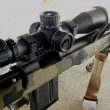



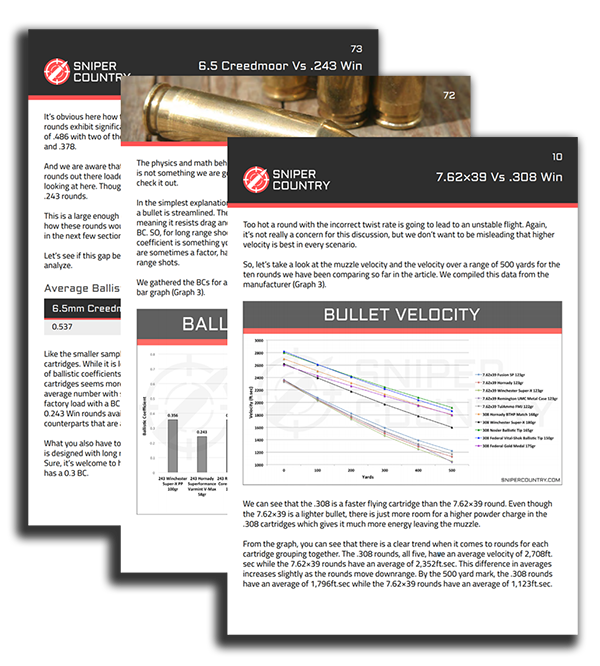

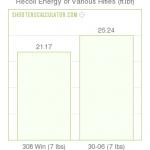
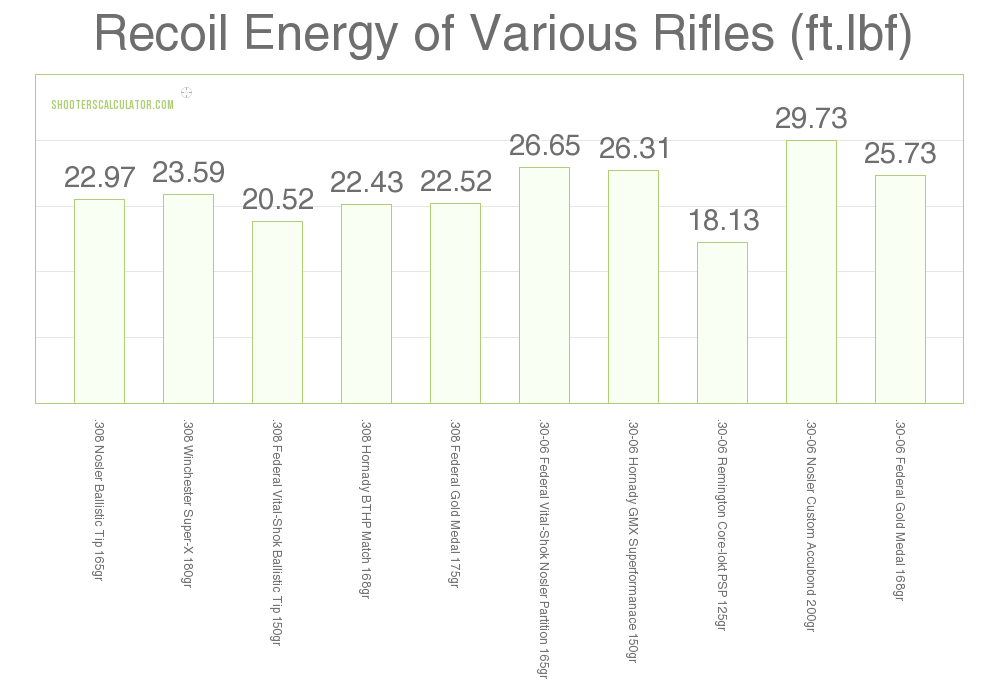
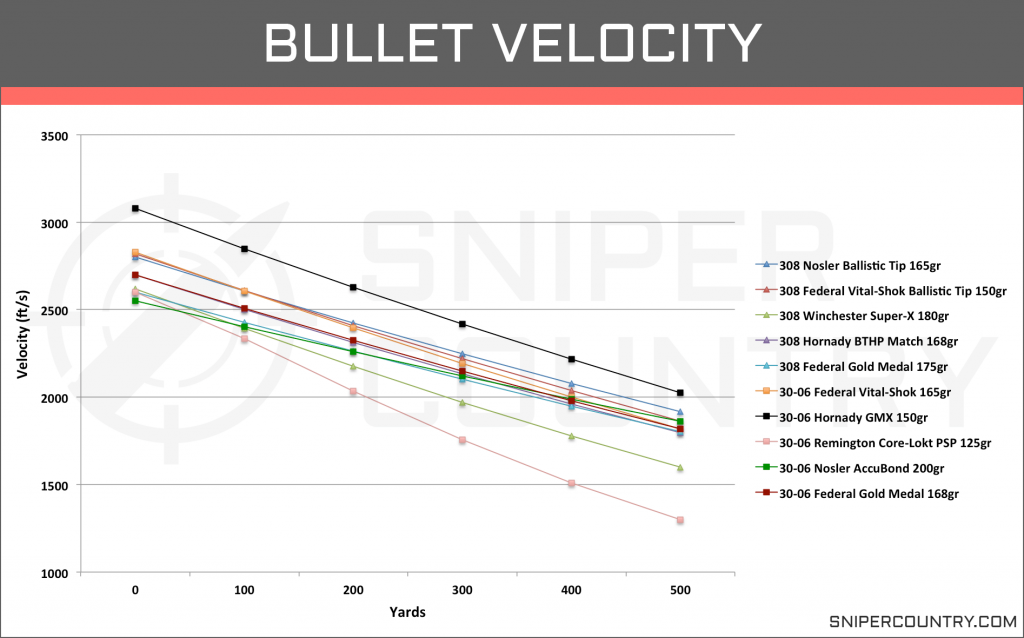

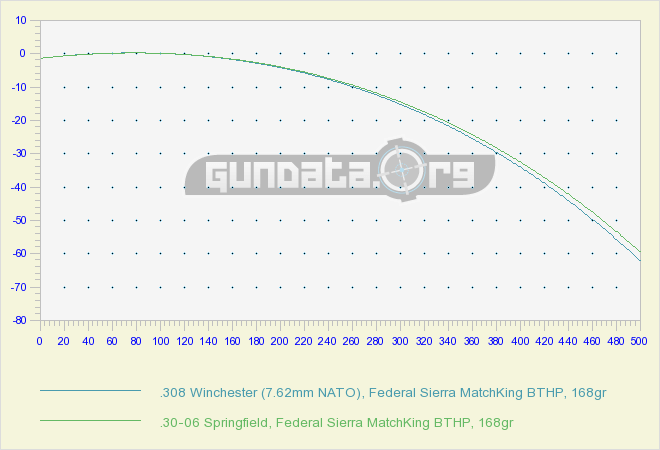
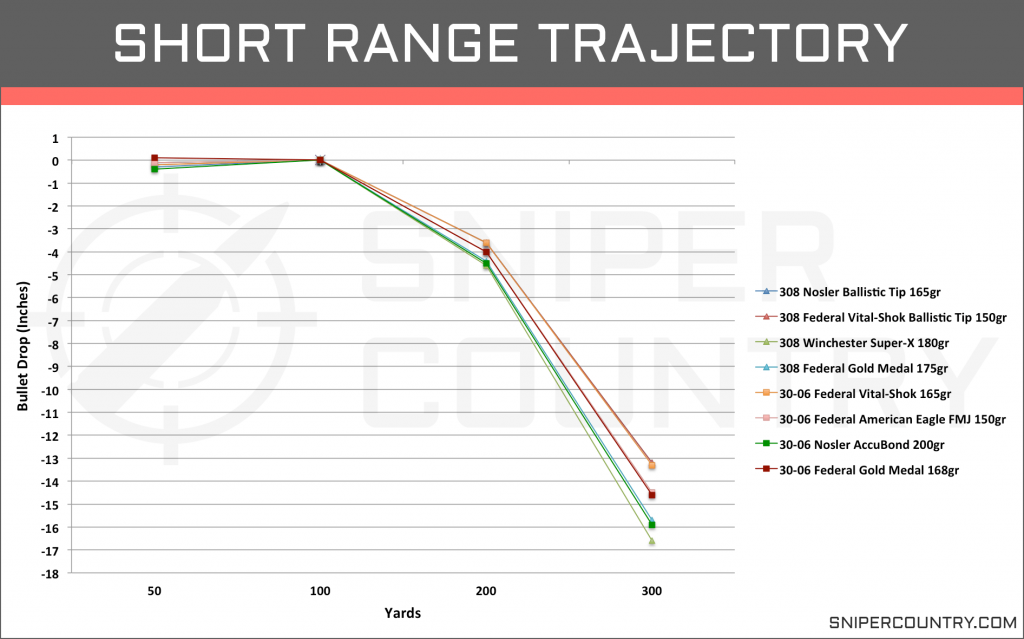
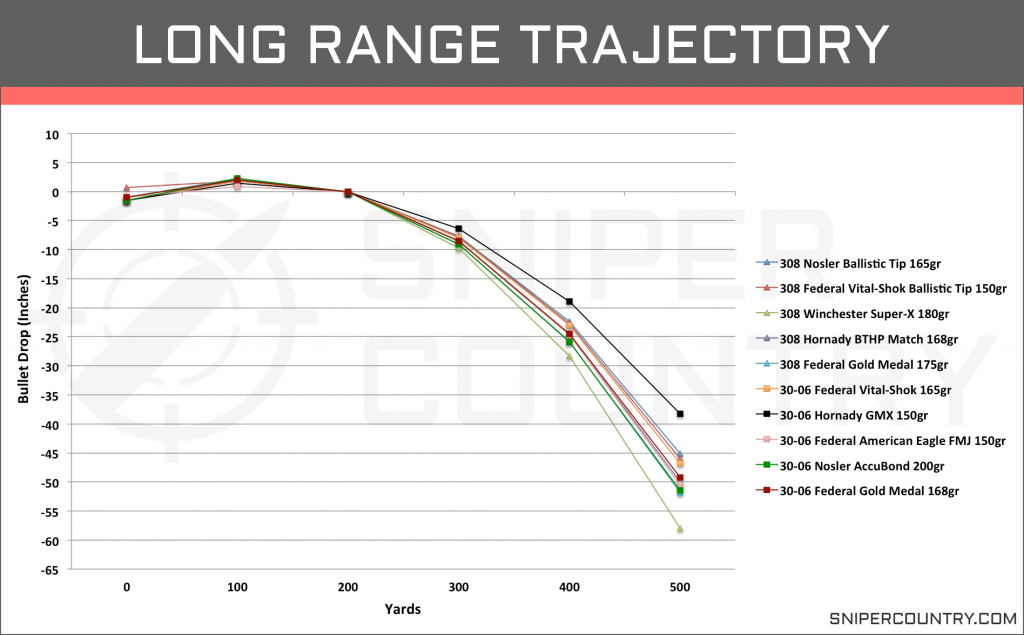

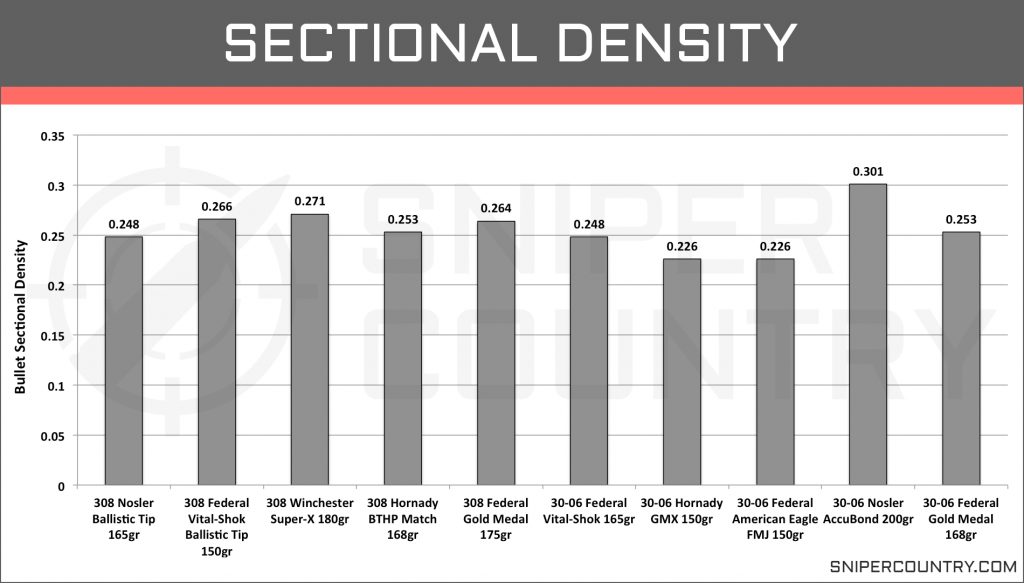


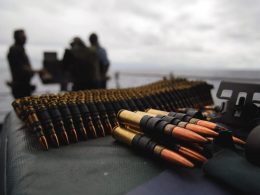
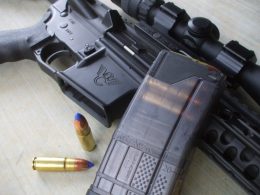

Great job you did. I just received the mail and i can’t read at all your study but i’ll take time to do it later.
Best regards.
Christian (from France) In the Alpes (of course)
The kinetic energy figure for the .30-06 relative to the .308 at 500 yards doesn’t make sense; either the .30-06 is lower, or the .308 is higher. The spread in energy decreases with distance, since energy decreases as the square of the velocity. But in this case, the difference between the two at 500 yards is greater than the distance between the two at 400 yards. That’s not plausible.
You are absolutely correct, this isn’t plausible. We had a look at the raw data and noticed that the .308 Winchester Ballistic Silvertip 168gr was listed with “229” instead of “1229” (ft.lbs) at 500 yards, which explains the discrepancy. Thanks for pointing that out to us, excellent spot!
damn fine article on the highly active discussion space of .308 vs 30-06. I would love to get the data files for this and slightly compress as well as overlay the round data so that you could see multiple data elements for each round and then have the ability to draw out the places where a specific round has characteristics that are optimized for a type of use case. thanks for also keeping the discussion about data and not stirring the pot because at the end of the day what we each pick and succeed with is sometimes field factor based and very unlike the lab conditions we need to have to know what contributed to the success of that shot/bullet/powder/gun/day/situation and as much as every shot is the same from the pull the trigger-hit the target, lots of variables go into what can make the next shot repeatable.
Thanks Brant! Give our ammo comparison tool a try, might be exactly what you are looking for.
I liked this very much but it did get a little long, that said I know it could have been much longer. Best of all you did a good job of using facts, and keeping your opinions out. Hard I know, we all have opinions. Here most big game hunters hunt deer and most most use the cheapest Winchester, Remington, Hornady ammo they can find. I wonder what you would find it you limited your ammo selection to that type. I just read another similar comment to this. The guy just said “I use Remington core locked, my deer are just as dead as yours” or something similar.
I own a 308 for target shooting out to 500. I own a 300 WM for hunting and occasional range use. I squeeze everything I can accurately shoot out of the 308. I down load the 300 to 06 ballistics. Hands down the 300 WM is the better performer using identical bullets. The 308 is a bench gun and the 300 is a hunting rifle. I use the 308 mostly due to the 300 recoil.
I submit that comparing the same weight of projectile is not a fair comparison.
Instead, why not use the projectile (for each case) that would assume the closest muzzle velocity between the two, making it an equivalent test?
The results will show the .30-06 has the case capacity to retain greater energy for a greater distance, with a higher ballistic coefficient.
Man, that 150gr Hornady GMX Superperformance in 30 06 is incredible but WOW, 55 dollars a box? Think I’m gonna stick with Core Lok and Power Shok except for special circumstances.
As an engineer, this article hurts my head. Both the .308 Win and .30-06 Spr use the exact same bullet diameter, so why not do an apple to apple comparison using the exact same bullets. Your results and data muddy the water and skew your results in favor of the 308. The bullets you chose to use for this test have different BCs and weights and will perform differently.
Let’s look at the Hornady 180 gr InterLock® SP. Both have cartridges made for the 308 Win and 30-06. In order to perform an apple to apple comparison, you need to use the same projectile. Going to Hornady’s Ballistic Calculator, let’s see how these 2 factory-loaded cartridges perform.
The .30-06 has a muzzle velocity of 2700ft/s and the .308 is at 2615ft/s. This yields a muzzle energy difference of 181 fps. At 500 yards, the 30-06 still is outperforming the .308 with ~100 fps of KE
I do not have a dog in this fight as I own rifles in both calibers. You just cannot compare a lightweight 308 to a heavier 30-06, even if you are averaging. In order to fairly compare the two, you need to compare performance on how they handle the same projectile.
My thoughts on comparing same bullets/ weights exactly.
Spot on. The 3006 has great capacity, period. The SAAMI pressure difference is due to older rifles in 30-06. By handloading or using premium light magnum xartridges of the same bullet weight the 3006 produces more velocity. Comparing ballistic coefficients makes no sense…they are both the same bore diameter.
My thoughts exactly. They fudge the “average” numbers in the .30-06 by adding a 125gr Corelokt psp (which has a bc of .268) and dragging the numbers down. However when it comes to a bc comparison, they trade the 125 for an American Eagle 150gr fmj. I don’t know why comparison writers can’t get rid of their own biases…
On paper this is mostly right but the 06 has 125 fps on lighter loads and 250 on heavy ones via our camps chronographs. Game performance for penetration, tracking and downed time: deer, bear and elk and I have owned and used both. Our camp has 30 hunters and a split on both. The 06 is noticeable in not recovering bullets, dropping game and less tracking even on deer. We all use 180 grain now on everything for 06 the 308 folks are split 150 and 180. Regardless even a double lung shot deer with 308 goes about 140 yds with 06 less than 50. In really life 06 is a lot more effective and it seems to favor the 180. This is weather an Accuebond or Round nose Remington. The 180 in the 06 is highly effective.
The differences between these two factory cartridges appear to be ‘recoil’ and ‘price per round’. What one might subsume under ‘power & performance’ (muzzle energy, velocity, ballistic coefficient, etc.) highlights instead how similar these two 30 cal rounds are.
Given the differences that do exist, a .308 is the smart choice. With less recoil it should provide a more pleasurable shooting experience, less flinching and therefore greater accuracy. With lower cost, it should allow for more practice time on the range, also improving a shooter’s accuracy. Furthermore, for those who seek more ‘power & performance’ than a .308, stepping up to a bigger caliber or magnum cartridge is preffereable to the rather tiny and possibly random performance increase of a 30-06. Which brings up the question: why choose a 30-06 factory load at all?